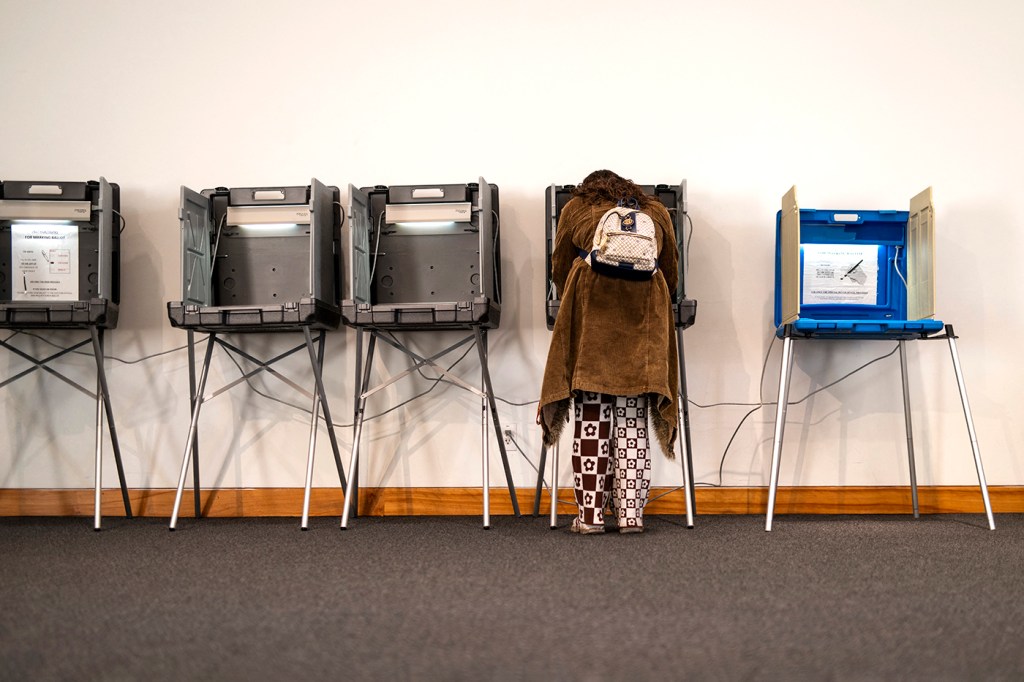2024 Election: Can new voters sway the tight race between Biden and Trump?
Katherine Haenschen, assistant professor of political science and communications studies at Northeastern, says she expects more young people to start paying attention to the presidential race after Thursday’s debate.

More than 8 million young people who were pre-teens when former President Donald Trump took office in 2017 and were in high school during President Joe Biden’s term will be eligible to vote for the first time in the 2024 presidential election.
Katherine Haenschen, assistant professor of political science and communications studies at Northeastern, says she expects more young people to start paying attention to the presidential race after Thursday’s first of two debates.
“We’ll start to see the polling start to shift a little bit,” Haenschen says.
Trump currently leads Biden by less than 2 percentage points, according to the Real Clear Politics polling average. However, among young voters ages 18-29, Biden leads 46% to 24%, according to Statistica.
Having lived through both administrations, how will the newest voters cast their ballots, and will their votes affect the result of the election?
In a close presidential race like this, says Costas Panagopoulos, the head of Northeastern University’s political science department, any group of voters can be quite important and consequential, including young voters.
“Even for these first-time voters in 2024, their experiences as adolescents have likely influenced their current political views, which will find expression in their voting decisions in this cycle,” Panagopoulos says.
Political views start to form in childhood and into adolescence, he says, influenced by family, social structures around young people and other factors, including their own personalities. Some studies, Panagopoulos says, suggest that the most formative age for political preferences is between 16 and 19 years old.
Although the newest voters were only 10 or 11 when Trump became president in 2017, they will remember their own feelings, Panagopoulos says, and the reactions of their parents and others around them to what was happening at the time of his presidency. First-time voters will be able to juxtapose those memories, he says, with more recent experiences with the Biden administration.
Familial views remain quite influential in explaining young voters’ political views, Panagopoulos says. Children can absorb what their families believed in and what they were talking about and expressing over the years.
Featured Posts
But there’s also usually a set of young individuals who reject the political views of their families and rebel against them.
“Sometimes we’re not even fully aware of the factors that are shaping our political views,” Panagopolous says.
There is some evidence in the political science literature, he says, that political leanings can be driven by genetics and other psychological factors.
For example, attachment styles — the ways people relate to others in close relationships depending on their early childhood bonds with their parents — are associated with different political orientations. Some studies show that people who developed insecure attachment styles, Panagopolous says, have difficulty trusting that their needs are going to be met by others and tend to develop more conservative views.
This year’s group of first-time voters might be affected by growing up in the global COVID-19 pandemic, he says, which heightened anxiety in society.
As the polling demonstrates, the youngest voters currently favor Biden over Trump.
“That could be not only because of their own experiences and recollections as adolescents and in early childhood,” Panagopolous says, “but also because of Trump’s policy positions on things important to young people like reproductive rights, LGBTQ+ rights, guns — all sorts of policy positions in which young people tend to adopt positions overall that are more closely related to Biden’s views than to Trump’s.”
These generational differences could challenge Trump in the 2024 elections and the Republican Party moving forward, he says, if this gap persists.
Economic concerns, according to the latest CBS News/YouGov poll, are a major factor in shaping the votes of 83% of all likely voters but also for 78% of young people. First-time voters definitely think about the economy, Panagopoulos says.
“It’s generally a time of economic anxiety, because they’re thinking about establishing themselves financially and thinking about families, and housing, and there are challenges associated with those things, except in times of abundance,” he says.
About 59% of young voters say they will definitely participate in voting even if they are dissatisfied with the presidential candidates on the ballot. The challenge for the candidates and their parties is getting them to the polls, Panagopolous says.
In the 2020 presidential election, 55% of young voters turned out at the polls — the largest youth turnout since the 1972 election.
In 2016, 44% of young voters — those ages 18-29 — cast ballots, similar to 45% in 2012 but not as great as the 51% in the 2008 election.
Most young voters this year, Haenschen says, will be choosing between voting for Biden or staying home.
Young people feel negative about politics today, she says, because they don’t see enough diversity in office and don’t feel represented by politicians who are mostly older and don’t hold the same values.
Social media platforms like Instagram and their algorithms are generally built in a way that people aren’t encountering political content and engaging with it, unless their friends are sharing it, Haenschen says.
“But this election is so important that we’re seeing a lot of discussion around the issues,” she says.
That is why one of the most effective ways to reach young people right now is through the influencers who already have large audiences of younger people and the online communities they’re part of.
“You might not be following a newspaper, but an influencer you’re interested in has been really vocal about trans rights or how abortion bans hurt women, and so there’s still political content,” Haenschen says. “I think you’ll see healthy turnouts this year.”











